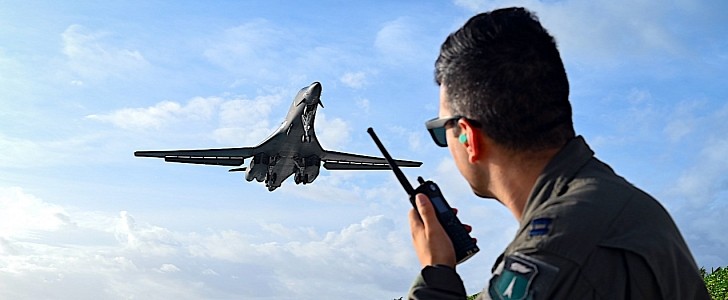In the world of military airplanes, bombers are discreet beasts. Being sent into the air on fewer occasions than fighter jets, and generally performing their duties at altitudes not easily accessible with the naked eye (and even technology), these metal birds sure are a sight for sore eyes every time they come closer to the ground.
Just like everything else in life, the bomber world has its stars as well, and the B-1B Lancer sure is on that short list. Patrolling the skies of the world since 1986, the Rockwell machine is increasingly being advertised by the U.S. Air Force through a series of photographs released now almost on a regular basis.
It was only yesterday when we were treated to a sight of such an airplane in action over the Persian Gulf, a masterly-executed pic that revealed just how impressive the Lancer looks in its natural element, as seen from above, and with the four General Electric turbofan engines shooting pointy plumes of flames out the rear.
Today’s Lancer treat shows one of these magnificent planes slowly gliding over a beach near the Naval Support Facility Diego Garcia in the Indian Ocean, located roughly at the middle point between Africa and Indonesia. The vista of this death bringer over the sandy beaches certainly is something we don’t see every day, but something the 37th Bomb Squadron weapons systems officer seen in the same pic has probably experienced before.
The Lancer we’re looking at now was about to land at the said base to support a Bomber Task Force mission, but we are not being told where it traveled from. For reference, the heavy bomber can fly for as much as 5,900 miles (9,400 km) and at speeds of up to Mach 1.2 if need be, ready to deliver its deadly, 75,000 lbs (34,019 kg) cargo of bombs.
It was only yesterday when we were treated to a sight of such an airplane in action over the Persian Gulf, a masterly-executed pic that revealed just how impressive the Lancer looks in its natural element, as seen from above, and with the four General Electric turbofan engines shooting pointy plumes of flames out the rear.
Today’s Lancer treat shows one of these magnificent planes slowly gliding over a beach near the Naval Support Facility Diego Garcia in the Indian Ocean, located roughly at the middle point between Africa and Indonesia. The vista of this death bringer over the sandy beaches certainly is something we don’t see every day, but something the 37th Bomb Squadron weapons systems officer seen in the same pic has probably experienced before.
The Lancer we’re looking at now was about to land at the said base to support a Bomber Task Force mission, but we are not being told where it traveled from. For reference, the heavy bomber can fly for as much as 5,900 miles (9,400 km) and at speeds of up to Mach 1.2 if need be, ready to deliver its deadly, 75,000 lbs (34,019 kg) cargo of bombs.












